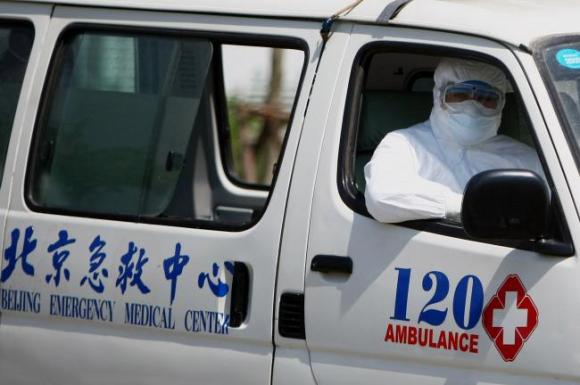
It’s an ill-kept secret that China is full of various counterfeits and bootlegs. The truth of it seems harmless enough when it’s limited to Hollywood films but recently the existence of phony ambulances has been brought to light by Beijing’s Morning Post. Apparently, China’s emergency medical transport system has been dispatching ill-suited medical vans and pulling in quite a profit doing so.
The story came to light thanks to a man named Lin, living in the city of Wenzhou. His wife had contracted a serious illness and was admitted into the intensive care unit of their local hospital, where she stayed for 40 days. It was then decided that she should be transferred to another hospital in Hangzhou, approximately 250 miles away. Obviously, she would not be able to survive such a long journey without appropriate medical care, and so an ambulance was called in. However, unbeknownst to anyone at the hospital, the artificial respirator on the ambulance was broken, and the medical staff on board had not been trained to handle anything related to terminal illnesses. Using a manual for necessary reference, the ambulance staff hooked the poor woman up to their broken respirator and drove off.
A short time after departing the hospital, Lin’s wife was struggling to breathe. Within minutes she was coughing up blood. The ambulance was forced to return to the original hospital, and the patient was returned to the ICU. By the following day she was still in a critical condition.
Lin was certain to contact the authorities about this suspicious, so-called ambulance. Surprisingly, the ambulance was legitimately registered with the government and belonged to a certain privately owned hospital. However, it was only certified to carry patients with non-life-threatening external wounds.
When Beijing’s Morning Post asked the vice-chair of the hospital why such an ill-equipped ambulance was sent to carry a critically ill patient for such a long distance, the man laughed and shirked all responsibility saying that they had no real understanding of the situation. He blames the problem on an overall lack of management for ambulances.
Why the city lacks the power to manage their emergency vehicles makes little sense, as they seem to receive plenty of funds. According to the owner and the driver of the ambulance which sparked all of this conversation, although this particular vehicle is owned by an individual, every time they are called to dispatch by the city’s emergency reception office, the person in charge of reception is given 20 percent on the transport fees as remuneration. These ambulance fees must be paid entirely by the patient, and are in no way cheap.
I’m starting to think that if I’m ever sick in China, I might spring for a taxi instead of an ambulance. At the very least, the fare is cheaper.
Source: Epoch Times (Japanese)

 Ambulance in China dumps patient after realizing he was already dead to help at other incident
Ambulance in China dumps patient after realizing he was already dead to help at other incident Japanese university lecturer arrested for assualting…an ambulance
Japanese university lecturer arrested for assualting…an ambulance Kobe City firefighters ask you to stop calling emergency numbers for trivial stuff like sunburns
Kobe City firefighters ask you to stop calling emergency numbers for trivial stuff like sunburns Man’s feet begin rotting following six-day online gaming binge in Chinese Internet café
Man’s feet begin rotting following six-day online gaming binge in Chinese Internet café Doctor punches patient in the stomach after his third visit to ER in one night
Doctor punches patient in the stomach after his third visit to ER in one night McDonald’s new Happy Meals offer up cute and practical Sanrio lifestyle goods
McDonald’s new Happy Meals offer up cute and practical Sanrio lifestyle goods All-you-can-drink Starbucks and amazing views part of Tokyo’s new 170 meter-high sky lounge
All-you-can-drink Starbucks and amazing views part of Tokyo’s new 170 meter-high sky lounge More foreign tourists than ever before in history visited Japan last month
More foreign tourists than ever before in history visited Japan last month Starbucks reopens at Shibuya Scramble Crossing with new look and design concept
Starbucks reopens at Shibuya Scramble Crossing with new look and design concept Hamster abandoned at Tokyo ramen restaurant gets new home
Hamster abandoned at Tokyo ramen restaurant gets new home The oldest tunnel in Japan is believed to be haunted, and strange things happen when we go there
The oldest tunnel in Japan is believed to be haunted, and strange things happen when we go there Studio Ghibli glasses cases let anime characters keep an eye on your spectacles
Studio Ghibli glasses cases let anime characters keep an eye on your spectacles Beautiful Sailor Moon manhole cover coasters being given out for free by Tokyo tourist center
Beautiful Sailor Moon manhole cover coasters being given out for free by Tokyo tourist center Mister Donut ready to make hojicha dreams come true in latest collab with Kyoto tea merchant
Mister Donut ready to make hojicha dreams come true in latest collab with Kyoto tea merchant Mr. Sato eats banana flower, still isn’t sure what it tastes like, loves it anyway【SoraKitchen】
Mr. Sato eats banana flower, still isn’t sure what it tastes like, loves it anyway【SoraKitchen】 Disney princesses get official manga makeovers for Manga Princess Cafe opening in Tokyo
Disney princesses get official manga makeovers for Manga Princess Cafe opening in Tokyo We try out “Chan Ramen”, an underground type of ramen popular in the ramen community
We try out “Chan Ramen”, an underground type of ramen popular in the ramen community Beautiful new Final Fantasy T-shirt collection on the way from Uniqlo【Photos】
Beautiful new Final Fantasy T-shirt collection on the way from Uniqlo【Photos】 Foreign English teachers in Japan pick their favorite Japanese-language phrases【Survey】
Foreign English teachers in Japan pick their favorite Japanese-language phrases【Survey】 Is the new Shinkansen Train Desk ticket worth it?
Is the new Shinkansen Train Desk ticket worth it? There’s a park inside Japan where you can also see Japan inside the park
There’s a park inside Japan where you can also see Japan inside the park Japanese convenience store packs a whole bento into an onigiri rice ball
Japanese convenience store packs a whole bento into an onigiri rice ball Studio Ghibli releases Kiki’s Delivery Service chocolate cake pouches in Japan
Studio Ghibli releases Kiki’s Delivery Service chocolate cake pouches in Japan Japan’s bone-breaking and record-breaking roller coaster is permanently shutting down
Japan’s bone-breaking and record-breaking roller coaster is permanently shutting down New definition of “Japanese whiskey” goes into effect to prevent fakes from fooling overseas buyers
New definition of “Japanese whiskey” goes into effect to prevent fakes from fooling overseas buyers Foreign passenger shoves conductor on one of the last full runs for Japan’s Thunderbird train
Foreign passenger shoves conductor on one of the last full runs for Japan’s Thunderbird train Our Japanese reporter visits Costco in the U.S., finds super American and very Japanese things
Our Japanese reporter visits Costco in the U.S., finds super American and very Japanese things Kyoto bans tourists from geisha alleys in Gion, with fines for those who don’t follow rules
Kyoto bans tourists from geisha alleys in Gion, with fines for those who don’t follow rules Studio Ghibli unveils Mother’s Day gift set that captures the love in My Neighbour Totoro
Studio Ghibli unveils Mother’s Day gift set that captures the love in My Neighbour Totoro Domino’s Japan now sells…pizza ears?
Domino’s Japan now sells…pizza ears? New Japanese KitKat flavour stars Sanrio characters, including Hello Kitty
New Japanese KitKat flavour stars Sanrio characters, including Hello Kitty Sales of Japan’s most convenient train ticket/shopping payment cards suspended indefinitely
Sales of Japan’s most convenient train ticket/shopping payment cards suspended indefinitely Sold-out Studio Ghibli desktop humidifiers are back so Totoro can help you through the dry season
Sold-out Studio Ghibli desktop humidifiers are back so Totoro can help you through the dry season Japanese government to make first change to romanization spelling rules since the 1950s
Japanese government to make first change to romanization spelling rules since the 1950s Ghibli founders Toshio Suzuki and Hayao Miyazaki contribute to Japanese whisky Totoro label design
Ghibli founders Toshio Suzuki and Hayao Miyazaki contribute to Japanese whisky Totoro label design Doraemon found buried at sea as scene from 1993 anime becomes real life【Photos】
Doraemon found buried at sea as scene from 1993 anime becomes real life【Photos】 Tokyo’s most famous Starbucks is closed
Tokyo’s most famous Starbucks is closed One Piece characters’ nationalities revealed, but fans have mixed opinions
One Piece characters’ nationalities revealed, but fans have mixed opinions We asked a Uniqlo employee what four things we should buy and their suggestions didn’t disappoint
We asked a Uniqlo employee what four things we should buy and their suggestions didn’t disappoint Princesses, fruits, and blacksmiths: Study reveals the 30 most unusual family names in Japan
Princesses, fruits, and blacksmiths: Study reveals the 30 most unusual family names in Japan Studio Ghibli’s new desktop Howl’s Moving Castle will take your stationery on an adventure
Studio Ghibli’s new desktop Howl’s Moving Castle will take your stationery on an adventure Japan’ deadliest New Year’s food may be even more dangerous in 2021 due to the coronavirus
Japan’ deadliest New Year’s food may be even more dangerous in 2021 due to the coronavirus Shiritsu Ebisu Chugaku idol Rina Matsuno passes away at 18
Shiritsu Ebisu Chugaku idol Rina Matsuno passes away at 18 Coronavirus gives birth to new “Screambulance” haunted house delivery in Japan【Photos】
Coronavirus gives birth to new “Screambulance” haunted house delivery in Japan【Photos】 93-year-old Japanese woman gifts ambulance worth 2.7 million yen to local fire station
93-year-old Japanese woman gifts ambulance worth 2.7 million yen to local fire station Japan’s amazing healthcare system summed up in photo of hospital bill for father’s heart surgery
Japan’s amazing healthcare system summed up in photo of hospital bill for father’s heart surgery Serious accidents from walking while using smartphone up over 50 percent in Tokyo
Serious accidents from walking while using smartphone up over 50 percent in Tokyo Man revives woman with AED, branded a “pervert” for removing her clothes to apply electrode pads
Man revives woman with AED, branded a “pervert” for removing her clothes to apply electrode pads Breaking: Passengers stabbed on Japanese train in Tokyo
Breaking: Passengers stabbed on Japanese train in Tokyo Beautiful highway in Japan has terrifying traffic safety reminder
Beautiful highway in Japan has terrifying traffic safety reminder Japanese love doll mistaken for drowned corpse, saved by emergency services anyway
Japanese love doll mistaken for drowned corpse, saved by emergency services anyway Manager poisons part-time worker in Japan because of “poor work ethic”
Manager poisons part-time worker in Japan because of “poor work ethic” How to get free healthcare in Japan without insurance
How to get free healthcare in Japan without insurance Woman kills self jumping onto train tracks, delay causes conductor to jump off tracks at other station
Woman kills self jumping onto train tracks, delay causes conductor to jump off tracks at other station Life saved in Tottori, Japan by same skin transplant treatment used for Kyoto Animation arsonist
Life saved in Tottori, Japan by same skin transplant treatment used for Kyoto Animation arsonist Anime studio attacked by arsonist, explosion leaves dozens injured, 12 dead
Anime studio attacked by arsonist, explosion leaves dozens injured, 12 dead In three months, 50 patients have died on one floor of a “haunted” hospital
In three months, 50 patients have died on one floor of a “haunted” hospital
Leave a Reply